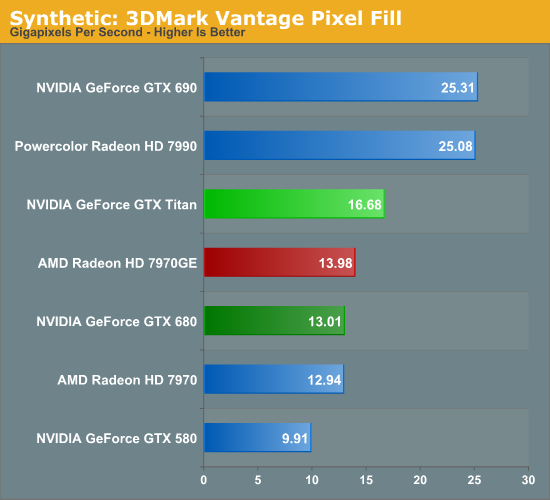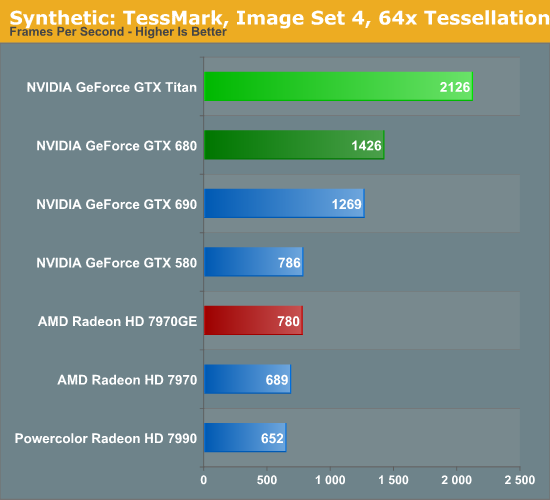NVIDIA’s GeForce GTX Titan Review, Part 2: Titan's Performance Unveiled
by Ryan Smith & Rahul Garg on February 21, 2013 9:00 AM ESTSynthetics
As always we’ll also take a quick look at synthetic performance to get a better look at Titan’s underpinnings. These tests are mostly for comparing cards from within a manufacturer, as opposed to directly comparing AMD and NVIDIA cards. We’ll start with 3DMark Vantage’s Pixel Fill test.

Pixel fill is a mix of a ROP test and a test to see if you have enough bandwidth to feed those ROPs. At the same time the smallest increase in theoretical performance for Titan over GTX 680 was in ROP performance, where a 50% increase in ROPs was met with a minor clockspeed reduction for a final increase in ROP performance of 25%.
The end result is that with gains of 28%, Titan’s lead over GTX 680 is just a hair more than its increase in theoretical ROP performance. Consequently at first glance it looks like Titan has enough memory and cache bandwidth to feed its 48 ROPs, which given where we’re at today with GDDR5 is good news as GDDR5 has very nearly run out of room.
Moving on, we have our 3DMark Vantage texture fillrate test, which does for texels and texture mapping units what the previous test does for ROPs.

Oddly enough, despite the fact that Titan’s texture performance improvements over GTX 680 were only on the range of 46%, here Titan is measured as having 62% more texturing performance. This may be how Titan is interplaying with its improved bandwidth, or it may be a case where some of the ancillary changes NVIDIA made to the texture paths for compute are somehow also beneficial to proper texturing performance.
Finally we’ll take a quick look at tessellation performance with TessMark.

Unsurprisingly, Titan is well ahead of anything else NVIDIA produces. At 49% faster it’s just a bit over the 46% theoretical performance improvement we would expect from the increased number of Polymorph Engines the extra 6 SMXes bring. Interestingly, as fast as GTX 580’s tessellation performance was, these results would indicate that Titan offers more than a generational jump in tessellation performance, nearly tripling GTX 580’s tessellation performance. Though at this time it’s not at all clear just what such tessellation performance is good for, as we seem to be reaching increasingly ridiculous levels.










337 Comments
View All Comments
UzairH - Thursday, February 21, 2013 - link
Ah ok, thanks for the explanation Ryan. Fair enough if the game is CPU bound, and your policy sounds fair as well. Please note however that at high resolutions enabling SSAO kills the performance, and enabling Transparency Anti-aliasing on top of that even more so, so even without mods Skyrim can still be pretty brutal on cards like the 670 and HD 7970.CeriseCogburn - Thursday, February 21, 2013 - link
LOL ignore the idiocy and buy the great nVidia card, you'll NEVER have to hear another years long screed from amd fanboys about 3G of ram being future-proof -ESPECIALLY WITH SKYRIM AND ADDONS!!!!As they screamed endlessly....
CeriseCogburn - Saturday, February 23, 2013 - link
It's a bunch of HOOEY no matter how reasonable "the policy" excuse sounds...http://www.bit-tech.net/hardware/2013/02/21/nvidia...
There's the Skyrim results, with TITAN 40+% ahead.
trajan2448 - Friday, February 22, 2013 - link
AMDs fps numbers are overstated. They figured out a trick to make runt frames, or frames which are not actually rendered to trigger the fps monitor as a real fully rendered frame. This is real problem for AMD much worse than the latency problem. Crossfire is a disaster which is why numerous reviewers including Tech Report have written that Crossfire produces higher fps but feels less smooth than Nvidia.Check this article out. http://www.pcper.com/reviews/Graphics-Cards/NVIDIA...
Ankarah - Thursday, February 21, 2013 - link
From a regular consumer's point of view, the hype it being the fastest 'single' graphics card doesn't really appeal that much - it doesn't make a difference to me how these video cards work in what configurations underneath its big case, as long as it does its job.So I really can't understand why any regular consumer would intentionally choose this over the 690GTX, which seems to be faster overall for the same price, unless you belong to perhaps 0.5% of their market share where you absolutely require FP64 executions for your work but don't really need the full power of Tesla.
And let's face it, if you are willing to shell out a grand for your graphics card for your PC, you aren't worried about the difference their TDP will make on your electric bills.
So I think it's just a marketing circus specifically engineered to draw in a lucky few, to whom money or price/performance ratio holds no value at all - there's nothing to see here for regular Joes like you and me.
Let's move along.
sherlockwing - Thursday, February 21, 2013 - link
This card is for people willing to spend at least $2K on their Graphic cards and don't want to deal with Quad GPU scaling while also having room for a Third. If you don't have that much cash you are not in its target audience.Ankarah - Thursday, February 21, 2013 - link
That makes sense,so this card, however we slice it, is only for about perhaps 1% of the consumer base if even that.
andrewaggb - Thursday, February 21, 2013 - link
pretty much. And bragging rights.CeriseCogburn - Thursday, February 21, 2013 - link
not for the crybabies we have here.Yet go to another thread and the screaming about the 7990 and the endless dual top end videocard setups with thousand dollar INTEL cpu's will be endless.
It all depends on whose diapers the pooing crybabies are soiling at the moment.
cmdrdredd - Thursday, February 21, 2013 - link
Plus people who want to break world records in benchmarking.